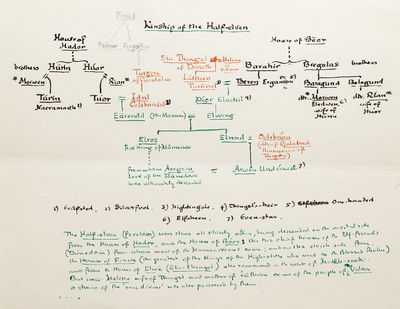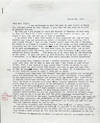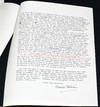Carousel content with 1 slides.
A carousel is a rotating set of images, rotation stops on keyboard focus on carousel tab controls or hovering the mouse pointer over images. Use the tabs or the previous and next buttons to change the displayed slide.
signed first edition
1964 · Oxford
by TOLKIEN, J.R.R.
Oxford: n.p., 1964. First edition. Very Good. - A MAJOR TOLKIEN AUTOGRAPH MANUSCRIPT ON THE CENTRAL THEMES OF HIS WORK AND CONTAINING A VARIANT HISTORY OF THE FIRST AGE; LIKELY THE MOST SIGNIFICANT MANUSCRIPT IN PRIVATE HANDS
- A VISUALLY STUNNING HAND-DRAWN CHART, "KINSHIP OF THE HALF-ELVEN," TRACING THE GENEALOGY FROM FËANOR TO ELROND, ARWEN, AND ARAGORN
- A LONG, REVEALING LETTER TO EILEEN ELGAR PRESENTING THE MANUSCRIPTS, REFLECTING ON THE RECENT DEATH OF C.S. LEWIS AND DISCUSSING LITERATURE AND WRITING, INCLUDING A DETAILED ANALYSIS OF HIS MIDDLE-EARTH POEM "FASTITOCALON". "Concerning 'The Hoard'" Manuscript:
Responding (truncated) to Eileen Elgar's letter about the meaning of Tolkien's poem "The Hoard," Tolkien here pens what he calls "a long screed" discussing the poem's themes and its relationship to his writing. Only recently published in The Adventures of Tom Bombadil and Other Verses from the Red Book (1962), "The Hoard" was a bardic poem telling of an ancient elven hoard successively claimed by a dwarf, a dragon, and a man - each of whom is killed in consequence of his feverish greed for the hoard. Tolkien here calls The Hoard "one of the main strands in The Silmarillion," and he explains that this work-in-process "concerns the great hoard of Nargothrond, which contained much of the treasure and works of Elvish art that had been preserved from the wreckage of the Elven-kingdoms and the assaults of the Dark Lord from his unassailable stronghold of Thangorodrim in the North." In endeavoring to give his correspondent a fuller idea of "what my proposed book, The Silmarillion, is about," Tolkien then proceeds to give a substantive account of the fate of this legendary hoard and its three great gemstones, the light-capturing silmarils magically crafted by Fëanor. The story arc and First-Age history Tolkien here charts differs in many subtle ways - especially in its rerouting of the Ruin of Doriath - from that found in The Simarillion and other related accounts of First Age history (e.g. the story of Nauglafring, as published in The Book of Lost Tales).
But Tolkien's essay "Concerning 'The Hoard'" is much more than a behind-the-scenes look into "The Hoard". The nature of obsession, discussed so vividly in "Concerning 'The Hoard'", is at the core of Tolkien's most celebrated works, namely: The Hobbit, The Lord of the Rings and The Silmarillion, and "Concerning 'The Hoard'"provides vital insight into the dramatic underpinnings of these works.
After explaining in this manuscript how "dark and secret hoards" were originally formed and indicating that such hoards are very often "possessed and guarded by a dragon," Tolkien affirms that such "dragon-hoards were cursed, and bred in men the dragon-spirit: in possessors an obsession with mere ownership, in others a fierce desire to take the treasure for their own by violence and treachery." Beyond the insight such a "dragon-spirit" offers for the immediate analysis of The Silmarillion - where even the noblest of heroes succumb to its obsessive poison and go to extreme lengths to obtain the silmarils - we see the "dragon-spirit" driving the actions surrounding the Arkenstone in The Hobbit and The One Ring in The Lord of the Rings. Tolkien's essay gives new meaning to the dragon Smaug's role in The Hobbit (and the reveling delight he takes in his hoard) and it further helps us understand the basis for Thorin Oakenshield's insatiable avarice and his fixation on recovering a treasure that he had never seen. In The Lord of the Rings we see Bilbo's reluctance to relinquish the One Ring and many of the early pages are occupied by Gandolf's explication to Frodo of how the Ring has affected its bearers. And who, after all, is Gollum but one who succumbed entirely to the "dragon-spirit"?
A major unpublished essay, "Concerning 'The Hoard'" is a highly important addition to Tolkien's known work. Broadening the characters and events of Middle-earth history, this manuscript affords us insight into Tolkien's evolving conception of the First Age. This manuscript was unknown to Christopher Tolkien at the time he was piecing together The Silmarillion, and one can only imagine the contribution its text might have made to that work. But even beyond its significance for The Silmarillion, this manuscript offers a penetrating view of how Tolkien conceived the "dragon-spirit" that is a driving force in all his major works. Encapsulating as it does the core history and thematic at the heart of Tokien's legendary works, "Concerning 'The Hoard'" is, to the best of our knowledge, the most significant Tolkien manuscript in private hands.
"Kinship of the Half-Elven" Genealogical Tree:
Tolkien's 1964 letter to Eileen Elgar also included the offered autograph genealogical tree entitled "Kinship of the Half-Elven". Tolkien was in the habit of creating itemized documents to help him keep track of the rich layers of detail present in his complex narrative structures. This particular tree begins with Fëanor in the early days of the First Age and traces his descent through the House of Hador and the House of Bëor to the Third-Age figures - Elrond, Arwen and Aragorn - we encounter in The Lord of the Rings. The chart is a stunning visual companion to his work, meticulously and stunningly drawn with black, green, and red ink and pencil.
Letter to Eileen Elgar:
Tolkien's letter of March 5, 1964, presenting the chart and manuscript to Eileen Elgar, begins on a somber note, with Tolkien explaining that he had been through some troubling times, highlighting that "The death of my friend (C.S. Lewis - whom I do not think you have confused with C.D. Lewis) was the first blow..." He then discusses "Concerning 'The Hoard', hoping that it will give Elgar a better idea of what "my proposed book, 'The Silmarillion' is all about." The rest of the letter is a detailed discussion of various aspects of writing and publishing: complaining about proofreaders' attempted changes to passages in The Lord of the Rings, an analysis of certain phrases with an explication of Chaucer and the nature of poetic meter, and a detailed analysis of his Middle-earth poem, "Fastitocalon," that had recently appeared in The Adventures of Tom Bombadil. It is both a highly literary and a deeply personal letter demonstrating the deep respect Tolkien held for Elgar.
_____
TOLKIEN, JOHN RONALD REUEL. Autograph Manuscript "Concerning 'The Hoard'". Oxford: n.p., [c.1964]. [Dimensions], 9 pp. on 5 leaves. Annotations and corrections in red ink, black ballpoint and pencil.
with
TOLKIEN, JOHN RONALD REUEL. Typed Letter Signed to Eileen Elgar, 5 March 1964. On Tolkien's embossed letterhead: "76 Sandfield Road" Excerpt printed in The Letters of J.R.R. Tolkien, ed. Humphrey Carpenter and Christopher Tolkien (Boston: Houghton Mifflin, 1981), no. 255.
with
TOLKIEN, JOHN RONALD REUEL. Autograph Genealogical Tree "Kinship of the Half-Elven". [Oxford]: n.p., [c.1964]. [Dimensions], 1 p. (Inventory #: 2800)
- A VISUALLY STUNNING HAND-DRAWN CHART, "KINSHIP OF THE HALF-ELVEN," TRACING THE GENEALOGY FROM FËANOR TO ELROND, ARWEN, AND ARAGORN
- A LONG, REVEALING LETTER TO EILEEN ELGAR PRESENTING THE MANUSCRIPTS, REFLECTING ON THE RECENT DEATH OF C.S. LEWIS AND DISCUSSING LITERATURE AND WRITING, INCLUDING A DETAILED ANALYSIS OF HIS MIDDLE-EARTH POEM "FASTITOCALON". "Concerning 'The Hoard'" Manuscript:
Responding (truncated) to Eileen Elgar's letter about the meaning of Tolkien's poem "The Hoard," Tolkien here pens what he calls "a long screed" discussing the poem's themes and its relationship to his writing. Only recently published in The Adventures of Tom Bombadil and Other Verses from the Red Book (1962), "The Hoard" was a bardic poem telling of an ancient elven hoard successively claimed by a dwarf, a dragon, and a man - each of whom is killed in consequence of his feverish greed for the hoard. Tolkien here calls The Hoard "one of the main strands in The Silmarillion," and he explains that this work-in-process "concerns the great hoard of Nargothrond, which contained much of the treasure and works of Elvish art that had been preserved from the wreckage of the Elven-kingdoms and the assaults of the Dark Lord from his unassailable stronghold of Thangorodrim in the North." In endeavoring to give his correspondent a fuller idea of "what my proposed book, The Silmarillion, is about," Tolkien then proceeds to give a substantive account of the fate of this legendary hoard and its three great gemstones, the light-capturing silmarils magically crafted by Fëanor. The story arc and First-Age history Tolkien here charts differs in many subtle ways - especially in its rerouting of the Ruin of Doriath - from that found in The Simarillion and other related accounts of First Age history (e.g. the story of Nauglafring, as published in The Book of Lost Tales).
But Tolkien's essay "Concerning 'The Hoard'" is much more than a behind-the-scenes look into "The Hoard". The nature of obsession, discussed so vividly in "Concerning 'The Hoard'", is at the core of Tolkien's most celebrated works, namely: The Hobbit, The Lord of the Rings and The Silmarillion, and "Concerning 'The Hoard'"provides vital insight into the dramatic underpinnings of these works.
After explaining in this manuscript how "dark and secret hoards" were originally formed and indicating that such hoards are very often "possessed and guarded by a dragon," Tolkien affirms that such "dragon-hoards were cursed, and bred in men the dragon-spirit: in possessors an obsession with mere ownership, in others a fierce desire to take the treasure for their own by violence and treachery." Beyond the insight such a "dragon-spirit" offers for the immediate analysis of The Silmarillion - where even the noblest of heroes succumb to its obsessive poison and go to extreme lengths to obtain the silmarils - we see the "dragon-spirit" driving the actions surrounding the Arkenstone in The Hobbit and The One Ring in The Lord of the Rings. Tolkien's essay gives new meaning to the dragon Smaug's role in The Hobbit (and the reveling delight he takes in his hoard) and it further helps us understand the basis for Thorin Oakenshield's insatiable avarice and his fixation on recovering a treasure that he had never seen. In The Lord of the Rings we see Bilbo's reluctance to relinquish the One Ring and many of the early pages are occupied by Gandolf's explication to Frodo of how the Ring has affected its bearers. And who, after all, is Gollum but one who succumbed entirely to the "dragon-spirit"?
A major unpublished essay, "Concerning 'The Hoard'" is a highly important addition to Tolkien's known work. Broadening the characters and events of Middle-earth history, this manuscript affords us insight into Tolkien's evolving conception of the First Age. This manuscript was unknown to Christopher Tolkien at the time he was piecing together The Silmarillion, and one can only imagine the contribution its text might have made to that work. But even beyond its significance for The Silmarillion, this manuscript offers a penetrating view of how Tolkien conceived the "dragon-spirit" that is a driving force in all his major works. Encapsulating as it does the core history and thematic at the heart of Tokien's legendary works, "Concerning 'The Hoard'" is, to the best of our knowledge, the most significant Tolkien manuscript in private hands.
"Kinship of the Half-Elven" Genealogical Tree:
Tolkien's 1964 letter to Eileen Elgar also included the offered autograph genealogical tree entitled "Kinship of the Half-Elven". Tolkien was in the habit of creating itemized documents to help him keep track of the rich layers of detail present in his complex narrative structures. This particular tree begins with Fëanor in the early days of the First Age and traces his descent through the House of Hador and the House of Bëor to the Third-Age figures - Elrond, Arwen and Aragorn - we encounter in The Lord of the Rings. The chart is a stunning visual companion to his work, meticulously and stunningly drawn with black, green, and red ink and pencil.
Letter to Eileen Elgar:
Tolkien's letter of March 5, 1964, presenting the chart and manuscript to Eileen Elgar, begins on a somber note, with Tolkien explaining that he had been through some troubling times, highlighting that "The death of my friend (C.S. Lewis - whom I do not think you have confused with C.D. Lewis) was the first blow..." He then discusses "Concerning 'The Hoard', hoping that it will give Elgar a better idea of what "my proposed book, 'The Silmarillion' is all about." The rest of the letter is a detailed discussion of various aspects of writing and publishing: complaining about proofreaders' attempted changes to passages in The Lord of the Rings, an analysis of certain phrases with an explication of Chaucer and the nature of poetic meter, and a detailed analysis of his Middle-earth poem, "Fastitocalon," that had recently appeared in The Adventures of Tom Bombadil. It is both a highly literary and a deeply personal letter demonstrating the deep respect Tolkien held for Elgar.
_____
TOLKIEN, JOHN RONALD REUEL. Autograph Manuscript "Concerning 'The Hoard'". Oxford: n.p., [c.1964]. [Dimensions], 9 pp. on 5 leaves. Annotations and corrections in red ink, black ballpoint and pencil.
with
TOLKIEN, JOHN RONALD REUEL. Typed Letter Signed to Eileen Elgar, 5 March 1964. On Tolkien's embossed letterhead: "76 Sandfield Road" Excerpt printed in The Letters of J.R.R. Tolkien, ed. Humphrey Carpenter and Christopher Tolkien (Boston: Houghton Mifflin, 1981), no. 255.
with
TOLKIEN, JOHN RONALD REUEL. Autograph Genealogical Tree "Kinship of the Half-Elven". [Oxford]: n.p., [c.1964]. [Dimensions], 1 p. (Inventory #: 2800)







